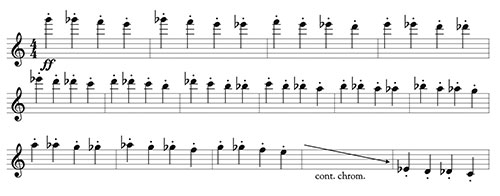 High Energy
High Energy
When I was a student at the Julius Baker Masterclass in Danbury, CT in the 1980’s, flutist Janet Millard lead us through morning warmups. Her class influenced the following warmup.
Use a metronome set at 60 or use an analog clock to tick off the seconds.
Play four staccato quarter notes with a breath attack, fortissimo. This type of breathing is like a slow, but forceful panting. You may repeat each chromatic group of four notes depending on how much time you have. Repeat using a T attack.

The point of this exercise is to get the air moving and flowing while playing the entire range of the flute.
Fall Out of Bed, Ease into the Day
This exercise was taught by Alexander Murray in the 1970’s and requires you to do practically nothing. The only energy required is enough to gently balance the flute into playing position. Feel the embouchure plate at your lips and greet the flute with enough gentle puffs of air to create a few whistle tones. Remember whistle tones? These are the residual soft little “whistles” that can also come when you’re not focusing the low register clearly.
In this exercise don’t focus the embouchure as if playing under normal circumstances, but instead totally relax your face. No smiling, frowning, or contorting the lip and facial muscles. The point is to create a sound with the least possible effort using only the lips on the embouchure plate. Select any of the lower notes in the first octave and play the whistle tone’s harmonic series.
Then finger at top octave B and play the whistle tone. Work your way down chromatically either as individual notes or slurring by twos. Less is more so use the least amount of air possible. Once you have produced the pitch, increase the air stream and focus on making the whistle tone louder and clearer. It sometimes helps to think of shaping the mouth as if really whistling.
Once you are confident in producing whistle tones, play simple melodies using whistle tones only. For inspiration see the U. S. Army Band’s listing of bugle calls: www.bands.army.mil/music/buglecalls/default.asp

Fine Tuning
Now that you are warmed up, practice playing the harmonic series on regularly fingered notes beginning on low C. Use as little embouchure movement as possible. The following series of notes is possible. This exercise develops the sound by adding more harmonic partials.

The bugle calls may also be repeated using the harmonic series.
From these exercises, progress to scales, etudes and repertoire.







